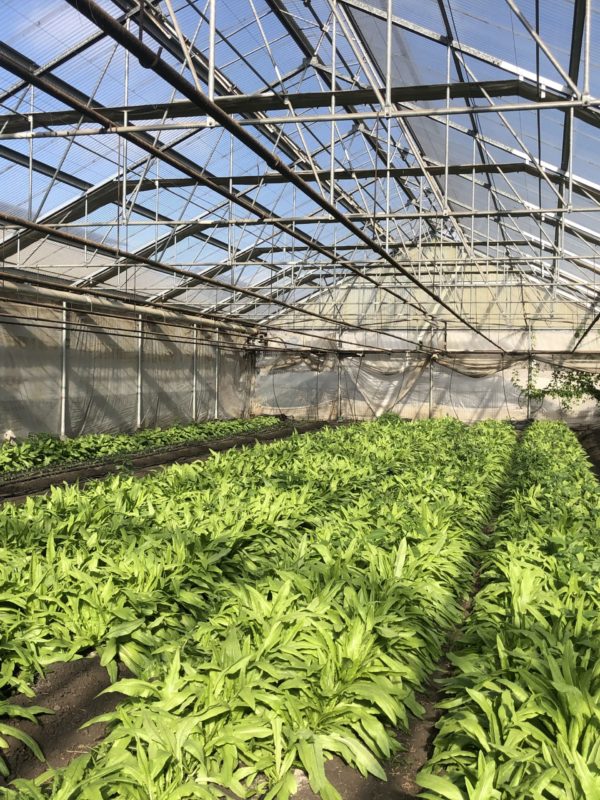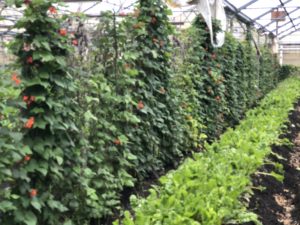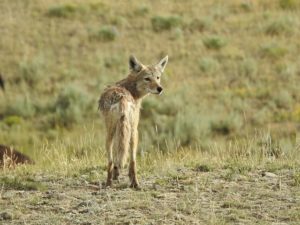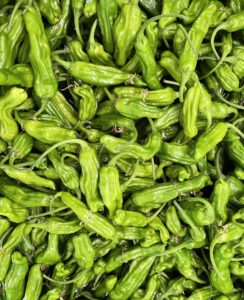Wild Life

“Back in the day,” as in “back in my great-grandfather’s day,” Watsonville was a “dry town.” A traveler heading on the dirt road out of town, bound for Santa Cruz didn’t need a road sign to tell them they’d reached the city limits because they had the swinging doors of the Whiskey Hill Saloon just over the line welcoming them to the unincorporated county territory. And five miles down the dirt road from Whiskey Hill through the apple orchards that carpeted the area was the first stage stop, a rustic roadhouse appropriately called “The Five Mile House.” Think of it as a 19th century truck stop/convenience store. There was hay and water for the teams of horses and mules and food and drink for the teamsters and travelers.
Except for drought and a persistent overdraft of our aquifer, Watsonville is hardly “dry” these days. I’m farming in a greenhouse complex just down the blacktop highway from the Five Mile House, which in its present day incarnation hosts Blossom’s Farm, a biodynamic cafe and boutique, plus a Mexican restaurant, and a tattoo parlor. Watsonville isn’t five miles away any longer either- it’s more like two miles through the fields from our greenhouse to the Quik Stop and first homes of town. Over the years most of the apple orchards in the Pajaro Valley have been cut down and replaced with strawberries or raspberries, but our little neighborhood still smells like apples in the fall from all the fruit on the ground. It still feels like we’re in the country, not the suburbs, and we have wildlife to deal with.
 The roof and walls of the greenhouse offer our crops shelter from the weather but they also shelter some critters The same plastic skin that filters the direct sunlight and gives the plants a luxurious, semi-tropical ambiance to thrive in also keeps the hawks and owls from doing their predators’ day and night vigilance, so any rabbits or squirrels that can make it inside have a safe space to munch on lettuces. Yes, I read The Tale of Peter Rabbit to my children when they were young, and I enjoyed the story just as much as they did, and I enjoyed it just as much as I had when my mother read it to me as a child, but I have to admit that as an adult- and a farmer- my sympathies are definitely with Mr. McGregor so the tale is more morally nuanced than it once seemed.
The roof and walls of the greenhouse offer our crops shelter from the weather but they also shelter some critters The same plastic skin that filters the direct sunlight and gives the plants a luxurious, semi-tropical ambiance to thrive in also keeps the hawks and owls from doing their predators’ day and night vigilance, so any rabbits or squirrels that can make it inside have a safe space to munch on lettuces. Yes, I read The Tale of Peter Rabbit to my children when they were young, and I enjoyed the story just as much as they did, and I enjoyed it just as much as I had when my mother read it to me as a child, but I have to admit that as an adult- and a farmer- my sympathies are definitely with Mr. McGregor so the tale is more morally nuanced than it once seemed.
At dawn, when we show up to work the dusty driveways in between the rows of greenhouses that make up the 15 acre complex show a variety of tracks that act as a visitors log for all the nighttime activity. We keep the greenhouse doors tight against any intruders, but there are always raccoon tracks and possum’s tracks. There’s a drain ditch dividing our green houses from the neighboring orchard, which the critters use as a veritable highway. The raccoons would like for nothing more than to remove burrito wrappers from the garbage can in the lunch area and lick the grease and beans from the foil before washing their hands in the ditch water. But neither they, not the possums, do much damage because they’re not that crazy about greens.
Sometimes we’ll see Blue Herons or Snowy Egrets hunting frogs in the ditch. I’m sad for the frogs, but I like to see these beautiful birds hunting. Besides frogs from the ditch, they’ll also eat gophers in the orchards. Gophers migrate under ground and can move miles over time, out of the orchard, under the ditch, under the dirt access road, under the green house walls, and into our plantings, so they’re bad news.
One morning I showed up just in time to see Miss Coyote slip past the water tank and trot down the alley between two green houses with her nose to the ground following a jack rabbit’s trail. I wished her success. And another morning I was surprised to see a little ferret emerge from a hole under the greenhouse wall and dart into a pile of pallets. Ferrets may be illegal as pets because they’re not native species and they rob songbirds’ nests of eggs, but I welcome them because they are relentless against rats, mice, and baby rabbits and squirrels.
down the alley between two green houses with her nose to the ground following a jack rabbit’s trail. I wished her success. And another morning I was surprised to see a little ferret emerge from a hole under the greenhouse wall and dart into a pile of pallets. Ferrets may be illegal as pets because they’re not native species and they rob songbirds’ nests of eggs, but I welcome them because they are relentless against rats, mice, and baby rabbits and squirrels.
And then there are people to worry about. There’s a cyclone fence with barbed wire and a padlock on the gate that faces what is now a busy highway to help keep out unwelcome human visitors. Because so many local green houses are given over to marijuana cultivation these days we need to keep the place almost hermetically sealed as there are always strangers wanting to enter to see if there’s any weed to steal.
The fence doesn’t enclose the drain ditch though, so we do get people walking back from the highway to investigate what we’re doing. And after 40 years of “Trickle down economics,” there are lots of homeless people in our area, just as there are in the big cities. There have been camps that sprang up back in the shelter of the orchard where the people couldn’t be seen. Some of these homeless folks are actually employed as farmworkers but can no longer pay their rents. We have come to expect to find the toilet paper to be taken from our porta potty from time to time. Sometimes people have broken into the greenhouses and taken harvest knives, hats, water bottles, and ice chests- even the bottles of hot sauce that the crew had left by the table in expectation of the next day’s lunch.
What’s the moral of the story?
 Time marches on and life on the farm is full of surprises. Luckily we have shishito peppers to enjoy flowing from the green houses now. They’re very easy to prepare. One way I like to cook them is to heat up a cast iron skillet and add just enough cooking oil to cover the bottom. Then toss a handful of peppers in- not so many that they cover the pan. Let the peppers toast until browned on one side and turn them. It shouldn’t take long. Then, with a sprinkle of salt you’re good to go. If you put too many peppers in at once they’ll tend to steam, not fry quickly; they’d still be good, but just not the same. The cooking time for the pan fried shishitos is so quick you’ll be able to make a second batch fast before your dinner guests eat them and before you have a chance to enjoy any. If the raccoons ever figure out how to fire up the little camp stove the crew uses to warm their tortillas for lunch we’ll have a real problem in the pepper patch! They know good food when they find it!
Time marches on and life on the farm is full of surprises. Luckily we have shishito peppers to enjoy flowing from the green houses now. They’re very easy to prepare. One way I like to cook them is to heat up a cast iron skillet and add just enough cooking oil to cover the bottom. Then toss a handful of peppers in- not so many that they cover the pan. Let the peppers toast until browned on one side and turn them. It shouldn’t take long. Then, with a sprinkle of salt you’re good to go. If you put too many peppers in at once they’ll tend to steam, not fry quickly; they’d still be good, but just not the same. The cooking time for the pan fried shishitos is so quick you’ll be able to make a second batch fast before your dinner guests eat them and before you have a chance to enjoy any. If the raccoons ever figure out how to fire up the little camp stove the crew uses to warm their tortillas for lunch we’ll have a real problem in the pepper patch! They know good food when they find it!
—© 2021 Essay by Andy Griffin. Photos of greenhouses and shishito peppers by Andy Griffin and picture of Coyote by Pixabay
~Special Note~
As the weather is getting warmer, the sun is rising earlier and the harvesting begins with the sunrise, we will be closing our East Bay/Peninsula shop by 6 PM on the Wednesday evenings before the Friday delivery. We close our San Francisco & Mystery Thursday shops on Wednesday mornings by 8 AM and our Santa Cruz/Los Gatos shop by 8 AM, on Monday mornings. Please get your orders in early so you don’t miss out on the harvest! Thank you all again for being such a part of our bountiful farm!
If you haven’t ordered a Mystery Box recently, now is a great time to get in on spring deliciousness! LadybugBuyingClub


